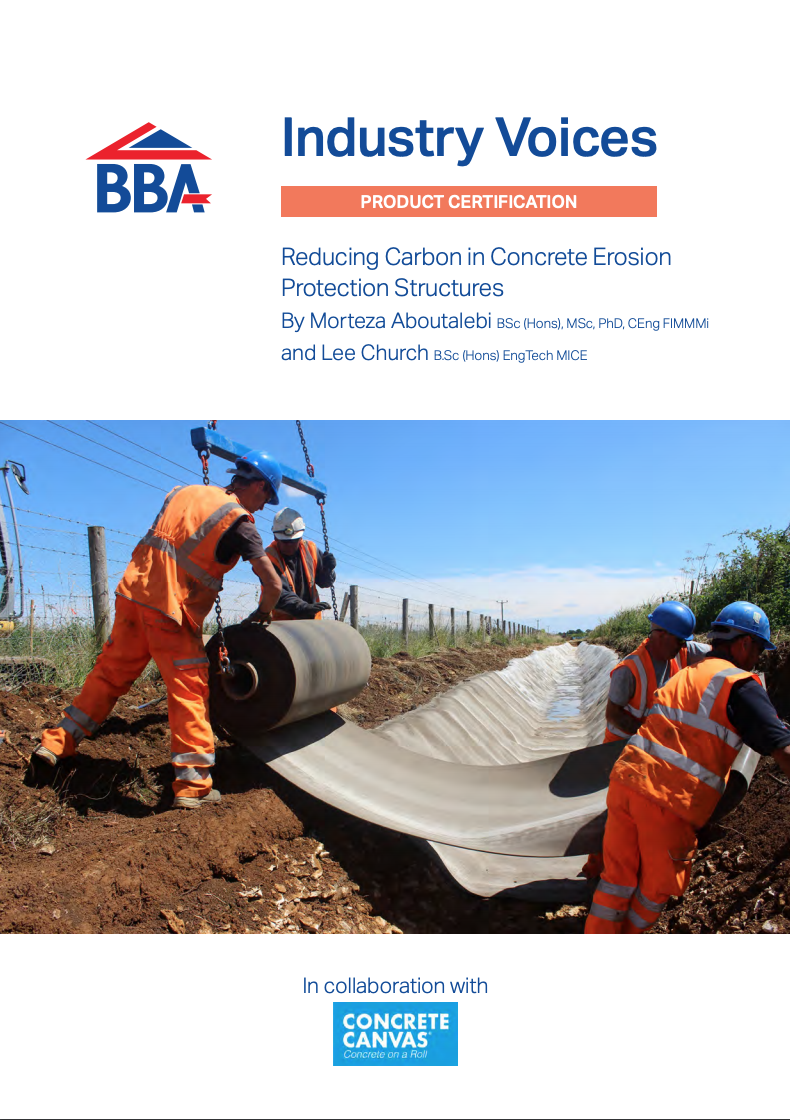Never waste a good crisis – is Net Zero an opportunity to tackle the link between standards and a reluctance to change in the construction industry?
There are some issues afflicting the construction industry that are so deep seated, or at least have such longevity that they sometimes feel like background noise. We’ve all been part of discussions about the ageing workforce, our flatlining productivity growth, or the idea that our commercial approaches are too transactional and confrontational.
The idea that construction is too slow to embrace innovation, and that standards are inadvertently stopping innovative solutions from being accepted, certainly falls into this category. Whilst acknowledging missed opportunities and unnecessary costs, the industry appears to accept that this is something we have to chip away at incrementally, or just work around.
Climate change and the UK’s legally binding commitment to reach Net Zero by 2050 does though start to make that approach look untenable.
If we look at just one group of products, it’s not hard to see why. Nature is one of many credible sources that report that cement manufacturing is responsible for 8% of global carbon emissions – and focuses attention on its use in the approximately 30 billion tonnes of concrete used globally each year. Ambitious plans to tackle this enormous carbon footprint, like National Highways’ commitment to Net Zero construction & maintenance by 2040, demand radical change delivered quickly, which the organisation is trying to drive through its routemaps for Net Zero concrete, steel and asphalt. The road operator has, however, the advantage of being a public sector monopoly, with a balanced scorecard of KPIs set by Ministers. It is also the long-term owner of any assets it builds and is able to self-insure. These are not luxuries available to businesses building or converting in the private sector, where room for manoeuvre in relation to low carbon materials is hemmed in by risk averse designers, clients, lenders and insurers.
A Routemap to Low Carbon Concrete – or a maze?
In the face of the climate challenge this is obviously a big problem. Carbon Capture and Storage (CCS) may be able to play a role in managing the impact of cement production – but we can’t escape the need to scale up options that lower the emissions generated by cement plants, reduce the amount of cement in concrete mixes and where possible eliminate its use altogether.
Construction leaders do of course know this. In April 2022 the Green Construction Board and the Institution of Civil Engineers launched a Low Carbon Concrete Routemap.
Unsurprisingly, action on standards plays an important role in the plan. One of seven work strands, Adapting New Technology is grounded in the principle:
Concrete that uses other cements or constituents outside of current standards will be a part of the overall solution…wherever possible and appropriate, new technologies should be supported by the industry to allow the accelerated development of new standards and an increase in commercial readiness and application.
This sounds promising, although it’s hard for one’s heart not to sink when the paper goes on to note that the process for updating a standard is a long one and provides a list of some of the key standards used to specify concrete and design concrete structures in the UK that may need attention:
- BS 8500:2019: Concrete (complementary British Standard to BS EN 206)
- BS EN 1992:2004 Eurocode 2 – Design of Concrete Structures
- BS EN 197-1: Cement – Composition, Specifications, and Conformity Criteria for Common Cements
- BS EN 197-5: Cement – Portland Composite Cement CEM II/C-M and Composite CEM VI
- BS EN 206: 2013 + A1: 206: Concrete Specification Performance Production and Conformity
- PAS 8820: 2016: Construction Materials: Alkali-Activated Cementitious Material (AACM) and concrete specification
These standards are interlinked, making the reform process even more complex. As an example, BS 8500 is in the process of being upgraded with a new version due for release in the autumn. As the Chair of the relevant BSI committee has explained this will facilitate the introduction of low carbon multi-component cements (with less high carbon clinker) into BS 8500 compliant concretes. This is only a partial solution. One industry expert has explained to the BBA that the revised BS 8500 will cross reference to a series of concrete mixes (CEM II/C-M and CEM VI) described in BS EN197-5. Unfortunately neither BS 8500 or BS EN197-5 are harmonised standards, limiting the impact of their use. BS EN 197-1 is a harmonised standard for common cements but is based on a cement’s formulation, rather than performance, limiting the scope for innovative, lower carbon recipes.
How can we do things differently?
This one small example suggests that getting to a set of standards and associated guidance that are fit for purpose to address the climate crisis in just this one (albeit important) area is going to be the work of a decade or more. This is a decade that we don’t have, as staying on course to Net Zero requires emissions to fall by circa 60% against 2019 levels over that period.
In some areas of the built environment, one part of the solution has been for stakeholders to collaborate with BSI to create a Publicly Available Specification a fast-track standardisation document that defines good practice for a product, service or process – for example the increasingly influential PAS 2080 – Carbon Management in Buildings and Infrastructure.
However, this approach is not feasible for all product sectors, and we certainly need to be questioning whether the current, volunteer committee-led process for creating and revising standards can be speeded up, without sacrificing quality. The Climate crisis is perhaps the opportunity to think creatively about other ways to evolve the UK standard-setting regime to facilitate innovation more broadly without sacrificing its vital role in underpinning safety and performance across the Built Environment.
Having spoken to a number of industry players about how we might move forward here are two suggestions for areas where dialogue with the British Standards Institute could be fruitful.
- An across the board move to performance-based standards: BS 8500 and BS EN 197-5 are both essentially recipe based standards, with the new version of the former set to widen the number of acceptable ingredients and how much of them can be used in the mix. We do in fact already have performance-based standards in areas such as masonry, so can we initiate an industry debate about the barriers to moving to such standards across the board. As we’ve seen, in the case of cement and concrete this would allow more flexibility and innovation to meet carbon and all other performance criteria.
- A case law approach to interpreting standards: Industry conservatism and standards are interrelated. Even where standards are in principle less prescriptive (like the masonry example above), a combination of time poor professionals and risk averse clients, funders and insurers mean the stomach for pushing the boundaries of their interpretation can be limited. One interesting idea would be for BSI standards committees to establish a mechanism for responding periodically to groups of queries about a standard’s interpretation to establish a kind of case law. If this was combined with a greater willingness to explain the reasoning behind decisions, for example by publishing redacted summaries of Standards Committee meetings, could this reduce the fear of ending up on the wrong end of a legal cross examination?
These 2 proposals may not survive contact with reality – but at this stage of the climate crisis the status quo is increasingly hard to defend. We would very much welcome any readers getting in touch with alternative suggestions that they think can make a difference.

AUTHOR PROFILE:
Andrew Crudgington is an independent researcher and writer who works across the built environment. Previously he was Director of Policy at the Institution of Civil Engineers.
Share This Story, Choose Your Platform!
Related News
Never waste a good crisis – is Net Zero an opportunity to tackle the link between standards and a reluctance to change in the construction industry?
There are some issues afflicting the construction industry that are so deep seated, or at least have such longevity that they sometimes feel like background noise. We’ve all been part of discussions about the ageing workforce, our flatlining productivity growth, or the idea that our commercial approaches are too transactional and confrontational.
The idea that construction is too slow to embrace innovation, and that standards are inadvertently stopping innovative solutions from being accepted, certainly falls into this category. Whilst acknowledging missed opportunities and unnecessary costs, the industry appears to accept that this is something we have to chip away at incrementally, or just work around.
Climate change and the UK’s legally binding commitment to reach Net Zero by 2050 does though start to make that approach look untenable.
If we look at just one group of products, it’s not hard to see why. Nature is one of many credible sources that report that cement manufacturing is responsible for 8% of global carbon emissions – and focuses attention on its use in the approximately 30 billion tonnes of concrete used globally each year. Ambitious plans to tackle this enormous carbon footprint, like National Highways’ commitment to Net Zero construction & maintenance by 2040, demand radical change delivered quickly, which the organisation is trying to drive through its routemaps for Net Zero concrete, steel and asphalt. The road operator has, however, the advantage of being a public sector monopoly, with a balanced scorecard of KPIs set by Ministers. It is also the long-term owner of any assets it builds and is able to self-insure. These are not luxuries available to businesses building or converting in the private sector, where room for manoeuvre in relation to low carbon materials is hemmed in by risk averse designers, clients, lenders and insurers.
A Routemap to Low Carbon Concrete – or a maze?
In the face of the climate challenge this is obviously a big problem. Carbon Capture and Storage (CCS) may be able to play a role in managing the impact of cement production – but we can’t escape the need to scale up options that lower the emissions generated by cement plants, reduce the amount of cement in concrete mixes and where possible eliminate its use altogether.
Construction leaders do of course know this. In April 2022 the Green Construction Board and the Institution of Civil Engineers launched a Low Carbon Concrete Routemap.
Unsurprisingly, action on standards plays an important role in the plan. One of seven work strands, Adapting New Technology is grounded in the principle:
Concrete that uses other cements or constituents outside of current standards will be a part of the overall solution…wherever possible and appropriate, new technologies should be supported by the industry to allow the accelerated development of new standards and an increase in commercial readiness and application.
This sounds promising, although it’s hard for one’s heart not to sink when the paper goes on to note that the process for updating a standard is a long one and provides a list of some of the key standards used to specify concrete and design concrete structures in the UK that may need attention:
- BS 8500:2019: Concrete (complementary British Standard to BS EN 206)
- BS EN 1992:2004 Eurocode 2 – Design of Concrete Structures
- BS EN 197-1: Cement – Composition, Specifications, and Conformity Criteria for Common Cements
- BS EN 197-5: Cement – Portland Composite Cement CEM II/C-M and Composite CEM VI
- BS EN 206: 2013 + A1: 206: Concrete Specification Performance Production and Conformity
- PAS 8820: 2016: Construction Materials: Alkali-Activated Cementitious Material (AACM) and concrete specification
These standards are interlinked, making the reform process even more complex. As an example, BS 8500 is in the process of being upgraded with a new version due for release in the autumn. As the Chair of the relevant BSI committee has explained this will facilitate the introduction of low carbon multi-component cements (with less high carbon clinker) into BS 8500 compliant concretes. This is only a partial solution. One industry expert has explained to the BBA that the revised BS 8500 will cross reference to a series of concrete mixes (CEM II/C-M and CEM VI) described in BS EN197-5. Unfortunately neither BS 8500 or BS EN197-5 are harmonised standards, limiting the impact of their use. BS EN 197-1 is a harmonised standard for common cements but is based on a cement’s formulation, rather than performance, limiting the scope for innovative, lower carbon recipes.
How can we do things differently?
This one small example suggests that getting to a set of standards and associated guidance that are fit for purpose to address the climate crisis in just this one (albeit important) area is going to be the work of a decade or more. This is a decade that we don’t have, as staying on course to Net Zero requires emissions to fall by circa 60% against 2019 levels over that period.
In some areas of the built environment, one part of the solution has been for stakeholders to collaborate with BSI to create a Publicly Available Specification a fast-track standardisation document that defines good practice for a product, service or process – for example the increasingly influential PAS 2080 – Carbon Management in Buildings and Infrastructure.
However, this approach is not feasible for all product sectors, and we certainly need to be questioning whether the current, volunteer committee-led process for creating and revising standards can be speeded up, without sacrificing quality. The Climate crisis is perhaps the opportunity to think creatively about other ways to evolve the UK standard-setting regime to facilitate innovation more broadly without sacrificing its vital role in underpinning safety and performance across the Built Environment.
Having spoken to a number of industry players about how we might move forward here are two suggestions for areas where dialogue with the British Standards Institute could be fruitful.
- An across the board move to performance-based standards: BS 8500 and BS EN 197-5 are both essentially recipe based standards, with the new version of the former set to widen the number of acceptable ingredients and how much of them can be used in the mix. We do in fact already have performance-based standards in areas such as masonry, so can we initiate an industry debate about the barriers to moving to such standards across the board. As we’ve seen, in the case of cement and concrete this would allow more flexibility and innovation to meet carbon and all other performance criteria.
- A case law approach to interpreting standards: Industry conservatism and standards are interrelated. Even where standards are in principle less prescriptive (like the masonry example above), a combination of time poor professionals and risk averse clients, funders and insurers mean the stomach for pushing the boundaries of their interpretation can be limited. One interesting idea would be for BSI standards committees to establish a mechanism for responding periodically to groups of queries about a standard’s interpretation to establish a kind of case law. If this was combined with a greater willingness to explain the reasoning behind decisions, for example by publishing redacted summaries of Standards Committee meetings, could this reduce the fear of ending up on the wrong end of a legal cross examination?
These 2 proposals may not survive contact with reality – but at this stage of the climate crisis the status quo is increasingly hard to defend. We would very much welcome any readers getting in touch with alternative suggestions that they think can make a difference.

AUTHOR PROFILE:
Andrew Crudgington is an independent researcher and writer who works across the built environment. Previously he was Director of Policy at the Institution of Civil Engineers.
Share This Story, Choose Your Platform!
Related News
Get in touch
Please complete the form below and we will contact you as soon as possible.
To help us to respond to your inquiry as quickly as possible, we have put a handy list of our services below.


